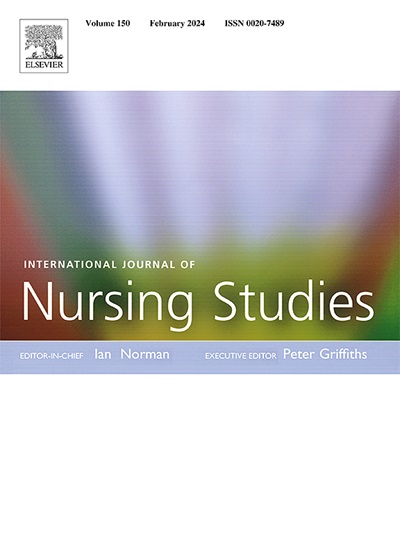Effects of three peripherally inserted central catheters insertion techniques on catheterization outcomes: A randomized controlled trial
IF 7.1
1区 医学
Q1 NURSING
引用次数: 0
Abstract
Background
Catheterization methods for peripherally inserted central catheters (PICC) mainly include the traditional method, one-needle subcutaneous tunnel catheterization, and two-needle subcutaneous tunnel catheterization, all of which are widely used in clinical practice. Researchers focus heavily on complications after these PICC catheterizations but ignore the effect of PICC catheterization process, such as one-time puncture success rate, patient experience, bleeding, and related issues.
Methods
This was a three-arm, parallel, randomized controlled trial. Patients were recruited from Zhongshan Hospital of Xiamen University in China between January and April 2025. Patients who met the inclusion criteria were randomly categorized into three groups. Primary indicators were the one-time puncture success rate, pain intensity, and total bleeding volume during catheterization. Secondary indicators included the blood oozing rate within 24 h after catheterization and catheterization operating time.
Results
In total, 681 patients were recruited. 226 in the traditional non-tunnel catheterization group, 232 in the one-needle subcutaneous tunnel catheterization group, and 223 in the two-needle subcutaneous tunnel catheterization group. The one-needle and two-needle subcutaneous tunnel catheterization groups demonstrated significantly better outcomes compared to the traditional non-tunnel catheterization group in terms of one-time puncture success rate (RD = 6.3 %, 95 % CI: 1.6 % to 11.1 %, P = 0.014; RD = 6.6 %, 95 % CI: 1.8 % to 11.3 %, P = 0.011) and blood oozing rate within 24 h after catheterization (RD = − 7.8 %, 95 % CI: − 13.5 % to − 2.0 %, P = 0.012; RD = − 8.3 %, 95 % CI: − 14.1 % to − 2.5 %, P = 0.007). Both the traditional non-tunnel catheterization group and the one-needle subcutaneous tunnel catheterization group demonstrated significantly lower values compared to the two-needle subcutaneous tunnel catheterization group in terms of total bleeding volume (MD = − 0.2, 95 % CI: − 0.3 to 0.0, P = 0.026; MD = − 0.2, 95 % CI: − 0.4 to − 0.1, P = 0.002), pain intensity (MD = − 0.2, 95 % CI: − 0.3 to − 0.1, P = 0.006; MD = − 0.2, 95 % CI: − 0.3 to − 0.1, P = 0.003), catheterization operating time (MD = − 0.9, 95 % CI: − 1.6 to − 0.2, P = 0.011; MD = − 1.0, 95 % CI: − 1.7 to − 0.3, P = 0.006).
Conclusion
One-needle subcutaneous tunnel catheterization was superior to the other two methods and did not cause nerve or blood vessel damage. It is recommended for clinical use.
Registration
Registered in the Chinese Clinical Trial Registry (ChiCTR2400094988, www.chictr.org.cn). The first recruitment was conducted in January 2025. https://www.chictr.org.cn/bin/project/edit?pid=242304.
三种外周置管技术对置管结果的影响:一项随机对照试验
背景PICC的置管方式主要有传统置管方式、一针皮下隧道置管方式和两针皮下隧道置管方式,在临床中应用广泛。研究人员主要关注PICC置管后的并发症,而忽略了PICC置管过程的影响,如一次性穿刺成功率、患者经验、出血等相关问题。方法三组、平行、随机对照试验。患者于2025年1月至4月在中国厦门大学中山医院招募。符合纳入标准的患者随机分为三组。主要指标为一次性穿刺成功率、穿刺疼痛强度、置管过程中总出血量。次要指标为置管后24h内渗血率及置管操作时间。结果共纳入681例患者。传统非隧道置管组226例,单针隧道置管组232例,双针隧道置管组223例。单针和双针皮下隧道导管组展示了更好的结果比传统non-tunnel导管组的一次性穿刺成功率(RD = 6.3%, 95%置信区间CI: 1.6%, 11.1%, P = 0.014; RD = 6.6%, 95%置信区间CI: 1.8%, 11.3%, P = 0.011)和血液渗出率后24小时内导管(RD =−7.8%,95%置信区间CI:−−2.0% 13.5%,P = 0.012; RD =−8.3%,95%置信区间CI:−−2.5% 14.1%,P = 0.007)。传统non-tunnel导管插入术组和演示的一针皮下隧道导管组显著降低值相比双针皮下隧道导管组的出血总量(MD =−0.2,95%置信区间CI: 0.3−0.0,P = 0.026; MD =−0.2,95%置信区间CI: 0.4−−0.1,P = 0.002),疼痛强度(MD =−0.2,95%置信区间CI: 0.3−−0.1,P = 0.006;MD =−0.2,95%置信区间CI: 0.3−−0.1,P = 0.003),导管操作时间(MD =−0.9,95%置信区间CI: 1.6−−0.2,P = 0.011; MD =−1.0,95%置信区间CI: 1.7−−0.3,P = 0.006)。结论一针皮下隧道置管术优于其他两种方法,且对神经和血管无损伤。推荐临床使用。注册:已在中国临床试验注册中心注册(ChiCTR2400094988, www.chictr.org.cn)。第一次招募于2025年1月进行。https://www.chictr.org.cn/bin/project/edit?pid=242304。
本文章由计算机程序翻译,如有差异,请以英文原文为准。
求助全文
约1分钟内获得全文
求助全文
来源期刊
CiteScore
15.00
自引率
2.50%
发文量
181
审稿时长
21 days
期刊介绍:
The International Journal of Nursing Studies (IJNS) is a highly respected journal that has been publishing original peer-reviewed articles since 1963. It provides a forum for original research and scholarship about health care delivery, organisation, management, workforce, policy, and research methods relevant to nursing, midwifery, and other health related professions. The journal aims to support evidence informed policy and practice by publishing research, systematic and other scholarly reviews, critical discussion, and commentary of the highest standard. The IJNS is indexed in major databases including PubMed, Medline, Thomson Reuters - Science Citation Index, Scopus, Thomson Reuters - Social Science Citation Index, CINAHL, and the BNI (British Nursing Index).

 求助内容:
求助内容: 应助结果提醒方式:
应助结果提醒方式:


